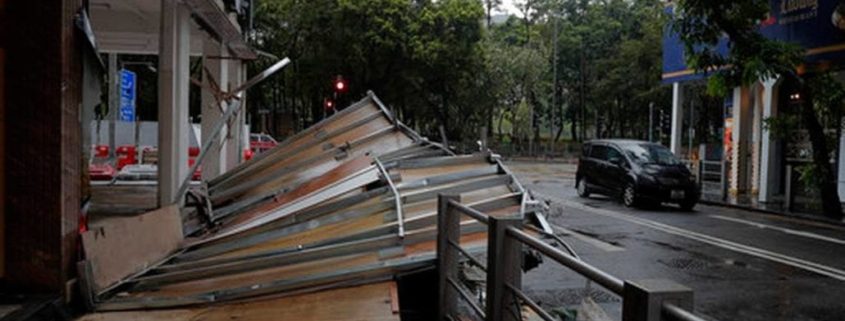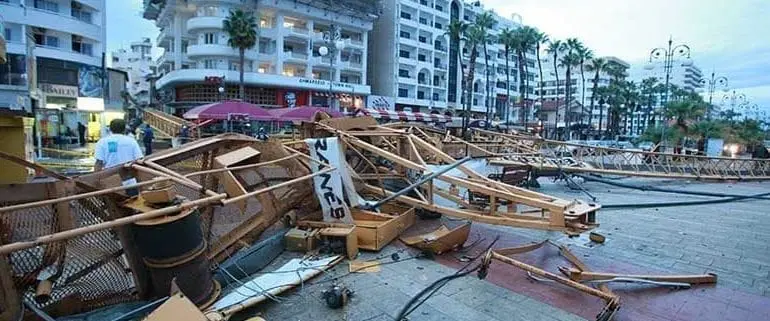Though many unfortunate factors can result in aviation accidents, among an aircraft’s greatest threats are ice, fog and wind shear, which is rapidly changing wind currents.
A National Transportation Safety Board (NTSB) study shows more than two-thirds of all weather-related general aviation crashes have been fatal.
Microbursts: An invisible killer
According to NASA, phenomena known as microbursts, which are short-lived downdrafts that are often present during thunderstorms, can create forceful and dangerous wind shear.
The National Weather Service (NWS) defines downdrafts as small-scale columns of air that rapidly sink toward the ground, usually accompanied by rain.
Planes are particularly vulnerable during takeoff and landing.
On July 9, 1982, a microburst brought down Pan Am flight 759 from New Orleans International Airport, killing 153 people.
It caused decreasing headwind and downdraft, which the pilot would have struggled to recognize in time, the NTSB official report concluded.
A microburst also caused Delta Airlines flight 191 to crash in Dallas on Aug. 2, 1985.
While attempting to pass through rain beneath a storm, it crashed 6,300 feet north of its runway at Dallas/Fort Worth International Airport, hitting and killing a driver, according to the NTSB report.
Lack of training and real-time wind shear hazard information contributed to the deaths of 134 passengers, the NTSB reported.
Between 1970 and 1985, low-altitude wind shear caused crashes that killed 575 people, according to the NTSB.
In 1988, the Federal Aviation Administration (FAA) mandated that commercial aircraft be equipped with wind shear detection systems by 1993.
“Wind shear accidents have become very rare in recent years thanks to better forecasting tools, pilot training and sophisticated onboard warning systems,” said Patrick Smith, an active airline pilot and air travel blogger.
“But the phenomena is still potentially dangerous,” he said.
Fatal fog risk
Foggy conditions are also often deadly for pilots, according to the Flight Safety Foundation.
They occur when water droplets suspend in the air at the Earth’s surface.
Hazards arise when visibility is reduced to a quarter of a mile or less, according to the National Oceanic and Atmospheric Association (NOAA).
In 1977, upon takeoff from Los Rodeos Airport in the Canary Islands, KLM flight 4805 sheared the top off Pan Am flight 1736, which shared the same runway.
According to the official report, heavy fog enveloping the airport prevented both flight crews from spotting each other until it was too late.
It was the deadliest fog-related crash in history, killing 574 people.
RELATED:
For the nervous passenger: 5 flying myths debunked
VIRAL: Lightning strikes plane midair
WOW! Lightning strikes plane over London
The control tower was unable to see the two planes, and at the time, the Los Rodeos Airport had no ground tracking radar.
A number of other factors, including poor communication, also contributed.
“The ultimate cause was the KLM pilot initiating takeoff without clearance and disregarding his crew’s inquiries about whether they were cleared for takeoff,” said aviation consultant Jim Goldfuss.
“Airport surveillance radars as well as taxiway and runway lighting technology has adapted to prevent accidents like this,” he said.
Icy aircraft dangers
Ice-covered planes pose another potentially deadly risk.
In 1982, 78 people perished when Air Florida flight 90 smashed into a bridge, collapsing into the icy Potomac River shortly after takeoff.

The tail section of the Air Florida jetliner that crashed in the Potomac River in Washington is hoisted by a crane onto a floating barge after being removed, Monday, Jan. 19, 1982 from the water. (AP Photo)
“Parked at the terminal, an aircraft collects precipitation the way your car does — via snowfall, sleet, freezing rain or frost,” Smith said.
Icing can disrupt airflow around a wing, which robs a plane of lift, he said.
Flight 90 departed Washington National Airport with icy wings during moderate to heavy snowfall, according to the crash report.
“[This] changes the wing’s shape, which can result in a stall at a higher-than-expected speed,” said Goldfuss.
The NTSB reported that the flight crew’s failure to use engine anti-ice before takeoff and their decision to depart with ice on the plane contributed to the crash.
A decade later, US Air flight 405 departed New York’s LaGuardia Airport, also with icy wings.
The plane lost lift just after leaving the runway and crashed into a nearby bay, killing 27.
It had been previously de-iced.
However, the NTSB concluded that the flight crew’s failure to check for ice accumulation on the wings 35 minutes after exposure to precipitation was a contributing factor to the crash, which occurred more than 20 years ago.
“We’ve come a long way with it as far as anti-icing and de-icing, as well as improved crew training and how to deal with icing conditions,” said Smith.
“Those [crashes] were tough lessons to learn,” said Smith, “but airliner crashes brought on by icing have become exceptionally rare.”
Author: Ashley Williams
Original Source and pictures: https://www.accuweather.com/en/weather-news/the-weather-hazards-behind-5-deadly-plane-crashes/70001522






